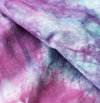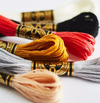Hand-dyed cross-stitch fabric is popular among stitchers for its unique, one-of-a-kind look. It adds a touch of artistry and individuality to your projects. Here's a breakdown of how hand-dyed cross-stitch fabric is made, including common methods, materials, and tips for trying it yourself.
🧵 Materials Used to Hand-Dye Cross-Stitch Fabric
-
Fabric:
- Common fabrics for cross-stitch, like Aida, Evenweave, or Linen, are best for dyeing.
-
Dye:
- Fabric dyes like Rit Dye, Dylon, or Procion MX dyes are commonly used.
- You can also use natural dyes from plants, flowers, or tea.
-
Fixatives:
- Salt or soda ash can help set the dye.
-
Tools:
- Plastic containers
- Gloves
- Plastic spoons
- Spray bottles (optional)
🎨 Common Methods for Hand-Dyeing Cross-Stitch Fabric
Here are the most popular dyeing techniques used by fabric dyers:
1️⃣ Immersion Dyeing (Solid or Gradient Colors)
-
Process:
The fabric is completely submerged in a dye bath for an even color or left in for varying amounts of time to create gradients. -
How to Do It:
- Mix your dye in a large container with hot water.
- Submerge the fabric for a few minutes to hours, depending on the desired intensity.
- Rinse thoroughly in cold water and hang to dry.
👉 Best For: Solid-colored fabrics or subtle gradients.
2️⃣ Tie-Dyeing (Marbled or Variegated Look)
-
Process:
The fabric is twisted, scrunched, or tied with rubber bands to create random patterns. -
How to Do It:
- Fold or scrunch the fabric into your desired shape.
- Apply dye in different areas using squeeze bottles or spray bottles.
- Let the fabric sit for several hours to absorb the dye.
- Rinse and dry.
👉 Best For: Marbled, cloud-like, or variegated fabrics.
3️⃣ Ice Dyeing (Watercolor or Abstract Effect)
-
Process:
Ice cubes are placed on top of the fabric, and powdered dye is sprinkled over the ice. As the ice melts, it creates beautiful watercolor effects. -
How to Do It:
- Place your fabric on a rack over a container to catch drips.
- Cover the fabric with ice cubes.
- Sprinkle powdered dye over the ice.
- Let the ice melt completely, rinse, and dry.
👉 Best For: Unique, abstract patterns with no two pieces alike.
Ice Dyeing Tutorial Video

4️⃣ Tea or Coffee Dyeing (Vintage Look)
-
Process:
The fabric is soaked in tea or coffee to achieve a soft, aged, vintage look. -
How to Do It:
- Brew a strong pot of tea or coffee.
- Submerge the fabric in the brew for 30 minutes to several hours.
- Rinse lightly and let it air dry.
👉 Best For: Antique or rustic cross-stitch projects.
5️⃣ Splatter or Spray Dyeing (Textured Look)
-
Process:
Dye is splattered or sprayed onto the fabric to create random, textured effects. -
How to Do It:
- Lay the fabric flat on a plastic surface.
- Use a spray bottle or flick dye with a brush or spoon onto the fabric.
- Let it dry and rinse.
👉 Best For: Bold, abstract designs.
🧼 How to Set the Dye
After dyeing, it's important to set the dye to prevent color bleeding when the fabric is washed.
- Rinse the fabric thoroughly in cold water until the water runs clear.
- Soak the fabric in a saltwater solution or vinegar bath to help set the color.
- Air dry the fabric completely before stitching.
🌈 Tips for Hand-Dyeing Fabric
- Wear gloves to avoid staining your hands.
- Test colors on scrap fabric before dyeing a large piece.
- Use multiple dye colors for a more complex look.
- Don’t overmix the dyes if you want a marbled or textured effect.
- Write down your process if you plan to recreate the same look later.
✂️ Pros and Cons of Hand-Dyed Fabric
| Pros | Cons |
|---|---|
| Unique, one-of-a-kind fabric | Can be messy and time-consuming |
| Adds depth and texture to projects | Colors may fade over time |
| Customizable to match your project | Some methods require special materials |
| Can achieve vintage or artistic effects | May require trial and error |
🧵 Can You Dye Aida, Linen, and Evenweave?
Yes! You can hand-dye all of these fabrics:
| Fabric Type | Dyeing Difficulty | Best Techniques |
|---|---|---|
| Aida | Easy | Immersion, Ice Dyeing, Tea Dyeing |
| Linen | Moderate | Tie-Dyeing, Gradient, Spray Dyeing |
| Evenweave | Moderate | Ice Dyeing, Spray Dyeing, Splatter |
🎨 DIY Hand-Dyeing vs. Buying Pre-Dyed Fabric
| DIY Hand-Dyeing | Buying Pre-Dyed Fabric |
|---|---|
| Full creative control | Convenient and ready to use |
| Less expensive in the long run | More consistent quality |
| Requires time and effort | Available in a wide range of colors |







